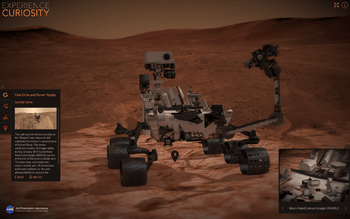Verge3D
Verge3D is a real-time renderer and a toolkit used for creating interactive 3D experiences running on websites.
 | |
| Developer(s) | Soft8Soft |
|---|---|
| Stable release | 2.16.0
/ October 30, 2019 |
| Written in | JavaScript, Python, GLSL |
| Type | 3D engine |
| License | Trialware |
| Website | www |
Overview
Verge3D enables users to convert content from 3D modeling tools (Autodesk 3ds Max and Blender are currently supported) for viewing in a web browser. Verge3D was created by the same core group of software engineers that previously created the Blend4Web framework.[1][2][3]
Features
Verge3D uses WebGL for rendering. It incorporates components of the Three.js library and exposes its API to application developers.[4]
- Puzzles
- Application functionality can be added via JavaScript, either by writing code directly or by using Puzzles, Verge3D’s visual programming environment based on Google Blockly. Puzzles is aimed primarily at non-programmers allowing quick creation of interactive scenarios in a drag-and-drop fashion.[5]
- App Manager and web publishing
- App Manager is a lightweight web-based tool for creating, managing and publishing Verge3D projects, running on top of the local development server.[6] Verge3D Network service integrated in the App Manager allows for publishing Verge3D applications via Amazon S3 and EC2 cloud services.
- PBR
- For purposes of authoring materials, a glTF 2.0-compliant physically based rendering pipeline is offered alongside with the standard shader-based approach.[7][8] PBR textures can be authored using external texturing software such as Substance Painter for which Verge3D offers the corresponding export preset.[9] Besides the glTF 2.0 model, Verge3D supports physical materials of 3ds Max (with Autodesk Raytracer as reference), and Blender 2.80's real-time Eevee materials.[10]
- glTF and DCC software integration
- Verge3D integrates directly with Blender and Autodesk 3ds Max, enabling users to create 3D geometry, materials and animations inside the software, then export them in the JSON-based glTF format. The Sneak Preview feature allows for exporting and viewing scenes from the DCC tool environment.[11][12]
- Facebook 3D posts
- For Facebook publishing, Verge3D offers a specific GLB export option.[13][14][15] The exported GLB files are displayed and can be opened in the App Manager.[16]
- Asset compression
- Exported files can optionally use LZMA compression[17], resulting in a reduction in file size of up to 6x.
- UI and website layouts
- Interface layouts, created using external WYSIWYG editors, can be linked with Puzzles to trigger changes to a 3D scene being rendered in the browser and vice versa.[18][19]
- Animation
- Verge3D supports skeletal animation, including animation of bipeds and character rigs, and allows for animation of material parameters. Model parts can also be set up to be dragged by the user.[20][21]
- Physics
- The physics module can be linked separately to enable collision detection, dynamically moving objects, support for characters and vehicles, springs, ropes and cloth simulation.[22][23] As of version 2.11, simple physics simulations can be created and controlled without coding via Puzzles, the visual programming system used by Verge3D.[24]
- AR/VR
- The 2.10 update added support for WebXR, an in-development open technology designed to enable virtual reality and augmented reality experiences to be displayed in web browsers. It works with both headsets with controllers, like the HTC Vive and Oculus Rift, and those without, like Google Cardboard. AR/VR experiences can enabled via Puzzles or JavaScript.[25]
Workflow
Verge3D's workflow differs substantially from other mainstream WebGL frameworks. Development of a new Verge3D application is usually started from modeling, texturing and animating 3D objects. The models are assembled in a 3D scene within a single *.max or *.blend file. This file is then used as a basis for a Verge3D project initialized from the App Manager. An interactive scenario is optionally added using the Puzzles editor overlay. A Verge3D application can be previewed in the web browser at any development stage using the App Manager. The finished web application can be deployed on the Verge3D Network, on Facebook or on the user's website.[26]

Notable uses
NASA's Jet Propulsion Laboratory used Verge3D to create an interactive 3D visualization of the Mars InSight lander.[27] The web application allows for exploring and interacting with the real-time model of the spacecraft, with the possibility to move different parts and unfurl the solar panels.
NASA's older interactive web application Experience Curiosity was ported to Verge3D from Blend4Web. The application makes it possible to operate the rover, control its cameras and the robotic arm and reproduces some of the prominent events of the Mars Science Laboratory mission.[28][29]
See also
References
- "Interactive 3D Web Content Comes to 3ds Max". engineering.com. Retrieved 2018-02-21.
- "Soft8Soft releases Verge3D". CG Channel. Retrieved 2017-12-05.
- "Раскол среди разработчиков проекта Blend4Web привёл к созданию нового WebGL-движка". OpenNews. Retrieved 2017-10-10.
- "Verge3D, solution de création d'applications web 3D interactives". 3DVF. Retrieved 2017-11-29.
- "Verge3D released". CGPress. Retrieved 2017-11-24.
- "Verge3D Launches". 3dxmedia. Retrieved 2017-11-22.
- "Verge3D 1.0. Il nuovo framework 3D WebGL per Blender". Treddi.com. Retrieved 2017-11-22.
- "VERGE3D 1.0发布!". BlenderCN.org. Retrieved 2017-11-22.
- "Verge3D 2.3 Blender版发布". BlenderCN.org. Retrieved 2018-04-22.
- "Soft8Soft releases Verge3D 2.9 for Blender and 3ds Max". CG Channel. Retrieved 2019-01-23.
- "Verge3D for 3DS Max released". CGPress. Retrieved 2018-02-09.
- "Soft8Soft Releases Verge3D for Autodesk 3ds Max". TenLinks. 2018-02-12. Retrieved 2018-02-12.
- "How to make Facebook 3D posts". 3D Print Tech Design. Retrieved 2018-05-07.
- "Verge3D for Blender version 2.2 is Out!". Dreammotion. Retrieved 2018-08-03.
- "How to export to GLB file with 3ds Max". Autodesk Knowledge Network. Retrieved 2019-01-23.
- "Verge3D 2.2 for 3DS Max released". CGPress. Retrieved 2018-03-18.
- "verge3d场景数据压缩". zjbcool.com. Retrieved 2018-06-03.
- "Soft8Soft releases Verge3D 2.3 for 3ds Max". CG Channel. Retrieved 2018-04-17.
- "Megjelent a Verge3D 2.3 for 3ds Max". MeshMag. Retrieved 2018-05-20.
- "Verge3D 2.5 is Out!". 80 Level. Retrieved 2018-07-24.
- "Soft8Soft ships Verge3D 2.5 for 3ds Max and Blender". CG Channel. Retrieved 2018-07-24.
- "Verge3D 2.4 for 3ds Max is out". Evermotion. Retrieved 2018-06-06.
- "Soft8Soft ships Verge3D 2.4 for 3ds Max and Blender". CG Channel. Retrieved 2018-06-07.
- "Soft8Soft releases Verge3D 2.11 for 3ds Max and Blender". CG Channel. Retrieved 2019-03-12.
- "Soft8Soft releases Verge3D 2.10 for 3ds Max and Blender". CG Channel. Retrieved 2019-02-11.
- "Soft8Soft Releases Verge3D v2.3 for Blender". Daily CADCAM. Archived from the original on 2018-05-07. Retrieved 2018-05-07.
- "MARS InSight Mission - InSight Lander". NASA. Retrieved 2018-10-31.
- "Prenez le controle de Curiosity avec Blend4Web". Greg G.d.Bénicourt. Retrieved 2015-09-16.
- "Internet 3D: Take the Curiosity Rover for a Spin Right on the NASA Website". Technology.Org. 2015-08-11. Retrieved 2015-08-12.